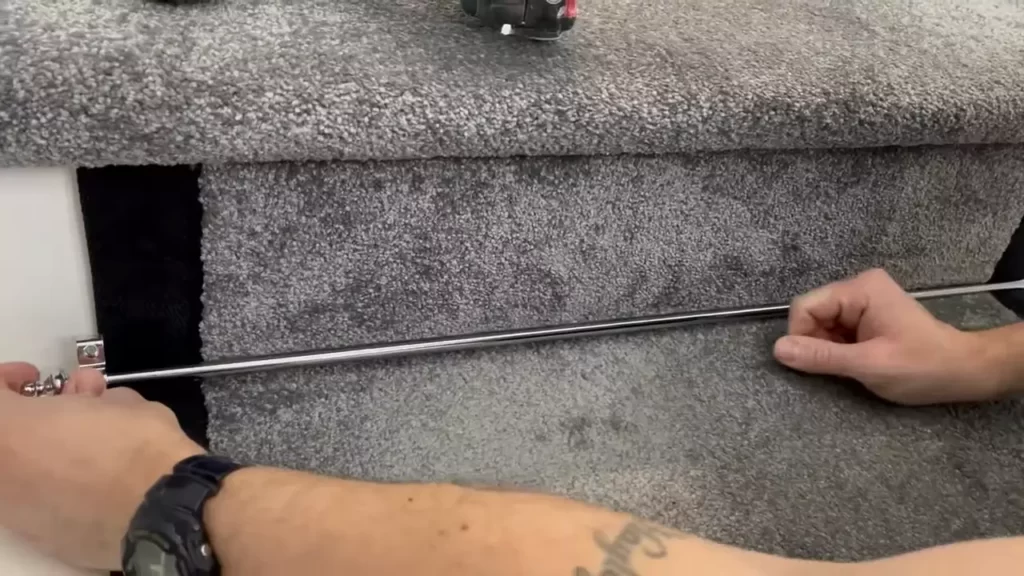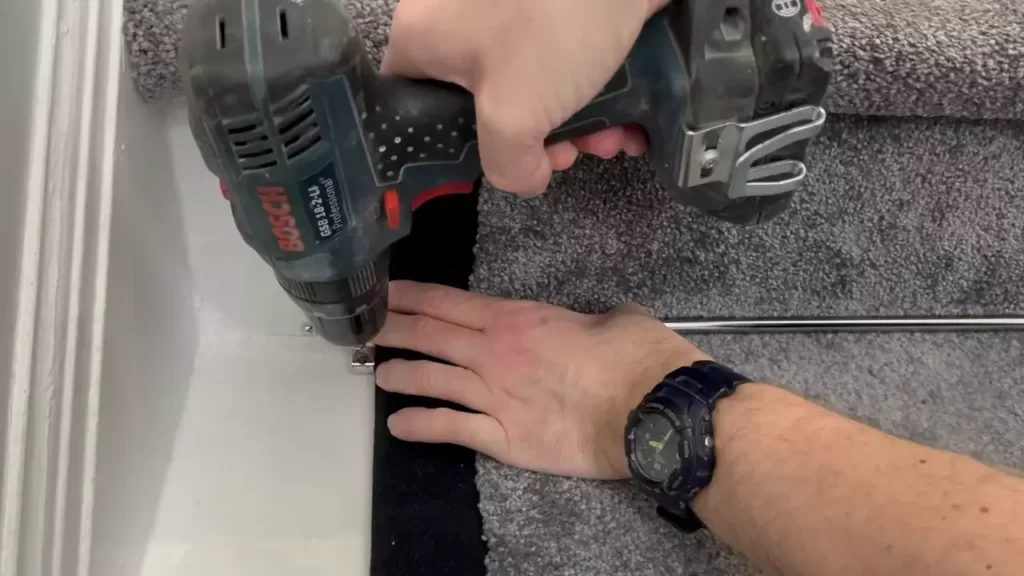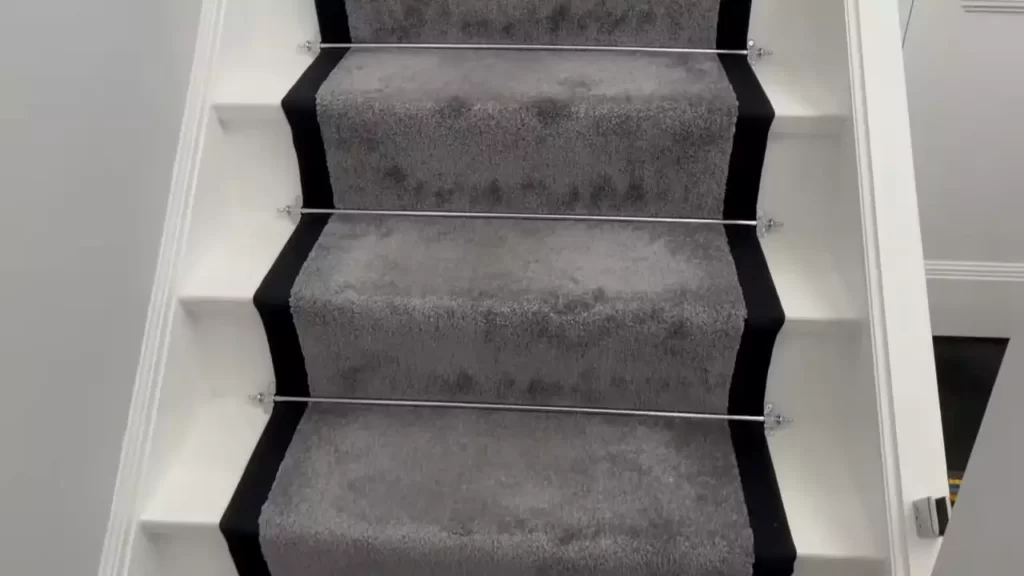To install a stair runner with rods, begin by measuring and cutting the runner to fit the staircase. Then, attach the rods to the stair treads using the provided brackets or clips, and secure the runner onto the rods using the included hardware.
Factors To Consider When Selecting Stair Runner Material
When it comes to installing a stair runner with rods, selecting the right material is crucial. The material you choose will not only impact the overall durability and maintenance requirements but also play a significant role in enhancing the style and aesthetic of your staircase. Below are three essential factors to consider when selecting stair runner material:
Durability
One of the most crucial factors to consider when choosing stair runner material is durability. Staircases experience heavy foot traffic, making it essential to opt for a material that can withstand daily wear and tear. Look for durable materials such as wool, which is known for its strength and resilience.
Wool stair runners are not only long-lasting but also have natural stain-resistance properties, making them an ideal choice for high-traffic areas. Another durable option is synthetic fibers like nylon or polyester, which are known for their durability and easy maintenance.

Style and Aesthetic
Alongside durability, the style and aesthetic of the material play a significant role in enhancing the overall look of your staircase. Consider the existing decor and color scheme of your home when choosing the stair runner material. While wool offers a classic and timeless look, synthetic fibers provide various patterns, colors, and textures to match your personal style.
Additionally, consider the pattern size and orientation of the material, ensuring it complements the size and shape of your stairs.
Maintenance Requirements
Lastly, it is essential to consider the maintenance requirements of the stair runner material. Different materials have varying maintenance needs, and it is important to select one that aligns with your lifestyle. Wool runners may require professional cleaning to maintain their quality and appearance.
On the other hand, synthetic fibers are often more resistant to stains and can be maintained with regular vacuuming and spot cleaning. It is important to choose a material that suits your ability and willingness to invest time and effort into its upkeep.
By considering these factors – durability, style and aesthetic, and maintenance requirements – you can select the perfect stair runner material that not only enhances the beauty of your staircase but also withstands the test of time.
Accurate Measurement Techniques For Stair Runners
When it comes to installing stair runners with rods, accurate measurement is crucial for ensuring a perfect fit. Taking precise measurements not only helps in determining the right amount of runner material needed but also ensures that the installation process goes smoothly. In this section, we will discuss the two key measurement techniques you should follow: measuring the staircase length and calculating the amount of runner material needed.
Measuring the Staircase Length
The first step in installing a stair runner with rods is to measure the length of your staircase. To get accurate measurements, follow these steps:
- Start at the bottom of the first riser and measure the length of the tread. This is the horizontal part of the step where your foot goes.
- Move to the next riser and measure the length of the tread again. Repeat this process for each riser until you reach the top of the staircase.
- Keep in mind that you should measure the tread only, excluding the riser (the vertical part of each step) and the nosing (the overhang of the tread).
- Add up all the measurements to get the total length of the staircase. This is the length you will use to calculate the amount of runner material needed.
By accurately measuring each tread, you will ensure that the stair runner fits snugly and avoids any gaps or overlaps.
Calculating the Amount of Runner Material Needed
Once you have the total length of your staircase, you can easily calculate the amount of runner material needed. Calculate it using the following formula:
(Total Length of Staircase + 12 inches) × Width of Stair Runner = Amount of Runner Material Needed
Before using the formula, make sure to add an additional 12 inches to the total length of the staircase. This additional length accounts for any necessary overhang at the top and bottom of the stairs, as well as for the curves and bends that may be present.
For example, if your total length is 10 feet (120 inches) and the width of your stair runner is 25 inches, the calculation would be as follows:
(120 + 12) × 25 = 3,300 square inches
Once you have the amount of runner material needed, you can purchase the appropriate length of runner for your staircase.
By following these accurate measurement techniques, you can confidently install a stair runner with rods, ensuring a perfect fit and a visually appealing result. Measure twice, cut once, and enjoy the beautiful transformation of your staircase!

Preparing The Stairs For Installation
Before you can start the installation process of a stair runner with rods, it is essential to properly prepare the stairs. This involves clearing the staircase of any obstacles and ensuring that the stairs are clean and ready for the installation. Following these steps will help you create a solid foundation for a successful stair runner installation.
Clearing the Staircase
The first step in preparing the stairs for installation is to clear the staircase of any obstacles. This includes removing any furniture, decor, or items that may obstruct the installation process. By ensuring a clear and open space, you can work efficiently and avoid any potential accidents. Take the time to remove any items that could get in the way or hinder your progress.
Cleaning the Stairs Properly
Cleaning the stairs thoroughly is another important step in preparing for the installation of a stair runner with rods. Any dirt, dust, or debris left on the stairs could affect the installation process and compromise the final result. To clean the stairs properly, follow these steps:
- Remove loose debris: Start by removing loose dirt, dust, or debris from the stairs. You can use a broom or a vacuum cleaner to ensure a thorough cleaning.
- Scrub the stairs: Depending on the material of your stairs, use an appropriate cleaner and scrub the stairs to remove any stubborn stains or grime. Be sure to follow the manufacturer’s instructions for cleaning the specific type of stairs you have.
- Rinse and dry: Once you have finished scrubbing the stairs, rinse them with clean water and dry them thoroughly. This is important to prevent any moisture from affecting the installation process.
By cleaning the stairs properly, you will create a clean and smooth surface for the installation of the stair runner, ensuring long-lasting and visually appealing results.
Now that you have cleared and cleaned the stairs, you are ready to move on to the next step in installing a stair runner with rods. Stay tuned for our next blog post, where we will guide you through the process of measuring and cutting the runner to fit your stairs perfectly.
Installing The Underlay And Gripper Rods
When it comes to installing a stair runner with rods, one of the most important steps is installing the underlay and gripper rods. This not only helps to protect your stairs from wear and tear but also ensures that the runner stays in place securely.

Choosing and Installing the Underlay
Before you can install the stair runner, you need to choose the right underlay. The underlay provides cushioning and helps to reduce noise when walking up and down the stairs. It also helps to extend the life of your runner by providing an extra layer of protection. When selecting the underlay, opt for a material that is durable and offers good grip.
Once you have chosen the underlay, it’s time to install it. Start by measuring the width of each step and cut the underlay accordingly. Lay the underlay on the first step, ensuring it covers the entire surface. Use a staple gun or double-sided tape to secure the underlay in place. Repeat this process for each step, making sure the underlay is smooth and free from any wrinkles or folds.
Installing the Gripper Rods
Gripper rods are essential for keeping the stair runner in place. These rods grip the carpet tightly, preventing it from slipping or bunching up. To install the gripper rods, you will need a few basic tools, including a tape measure, a hammer, and a pair of pliers.
Start by measuring the width of each step and cut the gripper rods accordingly. Place the rods at the bottom of the step, ensuring they are positioned close to the riser. Use a hammer to nail the rods into place, making sure they are secured firmly. Repeat this process for each step, ensuring that the rods are evenly spaced and securely attached.
Once the gripper rods are in place, it’s time to lay the stair runner over them. Start at the bottom of the steps and roll out the runner, making sure it is centered and straight. Gently press down on the runner to secure it to the gripper rods. If necessary, use a carpet stretcher to ensure a tight fit.
Attaching And Securing The Stair Runner
Now that you have aligned your stair runner properly, it’s time to secure it in place. There are two common methods of attachment: using staples or carpet tape. Let’s explore these options in detail.
Aligning the Runner Properly
Before attaching the stair runner, it’s important to ensure it is aligned properly. You want the runner to be centered on the stairs, with an equal amount of space visible on each side. This will create a balanced and visually pleasing look. To align the runner, you can follow these steps:
- Start by measuring the width of your stairs and the width of the runner. Divide the excess width of the runner by two to determine the gap required on each side.
- Using a measuring tape and pencil, mark the center point at the bottom of the stairs.
- Lay the runner on the stairs, starting from the bottom and working your way up.
- Adjust the runner so that it is centered with the help of the markings you made earlier.
- Make sure the runner is straight and not wrinkled or bunched up.
Securing the Runner with Staples or Carpet Tape
Once you have aligned the runner properly, it’s time to secure it in place. Depending on your preference and the type of runner you have, you can choose to use staples or carpet tape. Here are the steps for each method:
Securing the Runner with Staples:
If you opt for using staples, follow these steps:
- Start at the bottom of the stairs and work your way up.
- Hold the runner firmly in place, ensuring it’s aligned with the center markings.
- Using a staple gun, insert staples along the edges of the runner, approximately every six inches.
- Continue stapling until you reach the top of the stairs.
- Make sure the staples are inserted at an angle to properly secure the runner.
Securing the Runner with Carpet Tape:
If you prefer using carpet tape, follow these steps:
- Start at the bottom of the stairs and work your way up.
- Cut strips of double-sided carpet tape and place them along the edges of the runner, leaving a small gap between each strip.
- Peel off the backing of the carpet tape to expose the adhesive.
- Press the runner firmly onto the tape, ensuring it’s aligned with the center markings.
- Continue applying tape and pressing the runner until you reach the top of the stairs.
Whether you choose to use staples or carpet tape, make sure the runner is securely attached to prevent any slipping or accidents. Take your time and ensure each staple or strip of tape is properly placed to maintain a neat and tidy appearance.

Adding Finishing Touches And Final Steps
Congratulations! You’re almost done with installing your stunning stair runner with rods. Now it’s time to focus on adding those finishing touches and completing the final steps. Let’s dive in!
Trimming Excess Material
First, take a close look at the edges of your stair runner. You may notice some excess material that needs to be trimmed for a neat and clean finish. Using a sharp pair of scissors, carefully trim any extra fabric that extends beyond the sides of the stairs. Make sure to maintain a straight and even line throughout the trimming process.
Securing the Runner Edges
To ensure a secure and well-maintained stair runner, you’ll want to secure the edges properly. One effective technique is to use double-sided carpet tape or adhesive along the edges of the runner. This will help keep the runner in place, preventing any slippage or movement while adding an extra level of durability. Apply the tape or adhesive evenly on both sides to maintain a balanced look.
Cleaning up the Staircase Area
With your stair runner successfully installed, it’s time to remove any debris or dirt that may have accumulated during the installation process. Use a vacuum cleaner or a broom to thoroughly clean the staircase area, paying special attention to the edges and corners. This will give your newly installed stair runner a polished and pristine appearance.
Pro Tip: If you want to add an extra layer of elegance to your stair runner installation, consider adding decorative stair rod brackets. These stylish accessories not only enhance the overall aesthetic but also provide additional stability to the runner. Simply attach the rod brackets at regular intervals along the staircase and insert the rods through the designated openings in your runner.
Now that you’ve completed the final steps and added those finishing touches, step back and admire your beautiful stair runner with rods. Your hard work and attention to detail have transformed your staircase into a stunning focal point. Enjoy the visual appeal and comfort that your new runner brings to your home!
Frequently Asked Questions Of How To Install Stair Runner With Rods
Are Stair Rods A Good Idea?
Stair rods can add style and elegance to your staircase while also preventing slips and providing extra support. They are a good idea if you want to enhance the appearance and safety of your stairs.
Do You Need Stair Rods For Stair Runners?
Yes, stair rods are recommended for stair runners. They add a decorative touch and help secure the runner in place, preventing slipping and movement. Stair rods also enhance the overall aesthetic and provide a polished look to the staircase.
How Are Stair Rods Attached?
Stair rods are attached by placing them at the desired position on the stairs and then securing them with screws or adhesive. The rods are typically fixed into the stair tread and riser or the carpet runner, providing a decorative and functional element to the stairs.
How Do You Attach A Runner To Stairs?
To attach a runner to stairs, follow these steps:
1. Measure the width and length of the stairs.
2. Cut the runner to fit the measurements.
3. Use a staple gun or adhesive to secure the runner along the length of the stairs.
4. Smooth out any wrinkles or bubbles.
5. For added security, use rug grippers or double-sided tape to secure the edges.
Conclusion
Installing a stair runner with rods is a simple yet effective way to add style and function to your staircase. By following the step-by-step guide outlined in this blog post, you can elevate the overall look of your stairs while also providing added safety and comfort.
From choosing the right materials to properly securing the rods, this installation process is accessible to DIY enthusiasts of all levels. With a little patience and attention to detail, you can enjoy a beautiful and practical stair runner for years to come.
